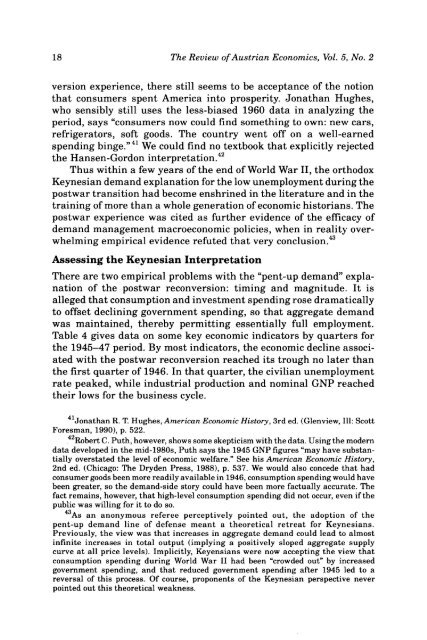Review of Austrian Economics - The Ludwig von Mises Institute
Review of Austrian Economics - The Ludwig von Mises Institute
Review of Austrian Economics - The Ludwig von Mises Institute
You also want an ePaper? Increase the reach of your titles
YUMPU automatically turns print PDFs into web optimized ePapers that Google loves.
18 <strong>The</strong> <strong>Review</strong> <strong>of</strong> <strong>Austrian</strong> <strong>Economics</strong>, Vol. 5, No. 2<br />
version experience, there still seems to be acceptance <strong>of</strong> the notion<br />
that consumers spent America into prosperity. Jonathan Hughes,<br />
who sensibly still uses the less-biased 1960 data in analyzing the<br />
period, says "consumers now could find something to own: new cars,<br />
refrigerators, s<strong>of</strong>t goods. <strong>The</strong> country went <strong>of</strong>f on a well-earned<br />
spending binge." 41 We could find no textbook that explicitly rejected<br />
the Hansen-Gordon interpretation. 42<br />
Thus within a few years <strong>of</strong> the end <strong>of</strong> World War II, the orthodox<br />
Keynesian demand explanation for the low unemployment during the<br />
postwar transition had become enshrined in the literature and in the<br />
training <strong>of</strong> more than a whole generation <strong>of</strong> economic historians. <strong>The</strong><br />
postwar experience was cited as further evidence <strong>of</strong> the efficacy <strong>of</strong><br />
demand management macroeconomic policies, when in reality overwhelming<br />
empirical evidence refuted that very conclusion. 43<br />
Assessing the Keynesian Interpretation<br />
<strong>The</strong>re are two empirical problems with the "pent-up demand" explanation<br />
<strong>of</strong> the postwar reconversion: timing and magnitude. It is<br />
alleged that consumption and investment spending rose dramatically<br />
to <strong>of</strong>fset declining government spending, so that aggregate demand<br />
was maintained, thereby permitting essentially full employment.<br />
Table 4 gives data on some key economic indicators by quarters for<br />
the 1945-47 period. By most indicators, the economic decline associated<br />
with the postwar reconversion reached its trough no later than<br />
the first quarter <strong>of</strong> 1946. In that quarter, the civilian unemployment<br />
rate peaked, while industrial production and nominal GNP reached<br />
their lows for the business cycle.<br />
41 Jonathan R. T. Hughes, American Economic History, 3rd ed. (Glenview, 111: Scott<br />
Foresman, 1990), p. 522.<br />
42 Robert C. Puth, however, shows some skepticism with the data. Using the modern<br />
data developed in the mid-1980s, Puth says the 1945 GNP figures "may have substantially<br />
overstated the level <strong>of</strong> economic welfare." See his American Economic History,<br />
2nd ed. (Chicago: <strong>The</strong> Dryden Press, 1988), p. 537. We would also concede that had<br />
consumer goods been more readily available in 1946, consumption spending would have<br />
been greater, so the demand-side story could have been more factually accurate. <strong>The</strong><br />
fact remains, however, that high-level consumption spending did not occur, even if the<br />
public was willing for it to do so.<br />
As an anonymous referee perceptively pointed out, the adoption <strong>of</strong> the<br />
pent-up demand line <strong>of</strong> defense meant a theoretical retreat for Keynesians.<br />
Previously, the view was that increases in aggregate demand could lead to almost<br />
infinite increases in total output (implying a positively sloped aggregate supply<br />
curve at all price levels). Implicitly, Keyensians were now accepting the view that<br />
consumption spending during World War II had been "crowded out" by increased<br />
government spending, and that reduced government spending after 1945 led to a<br />
reversal <strong>of</strong> this process. Of course, proponents <strong>of</strong> the Keynesian perspective never<br />
pointed out this theoretical weakness.

















